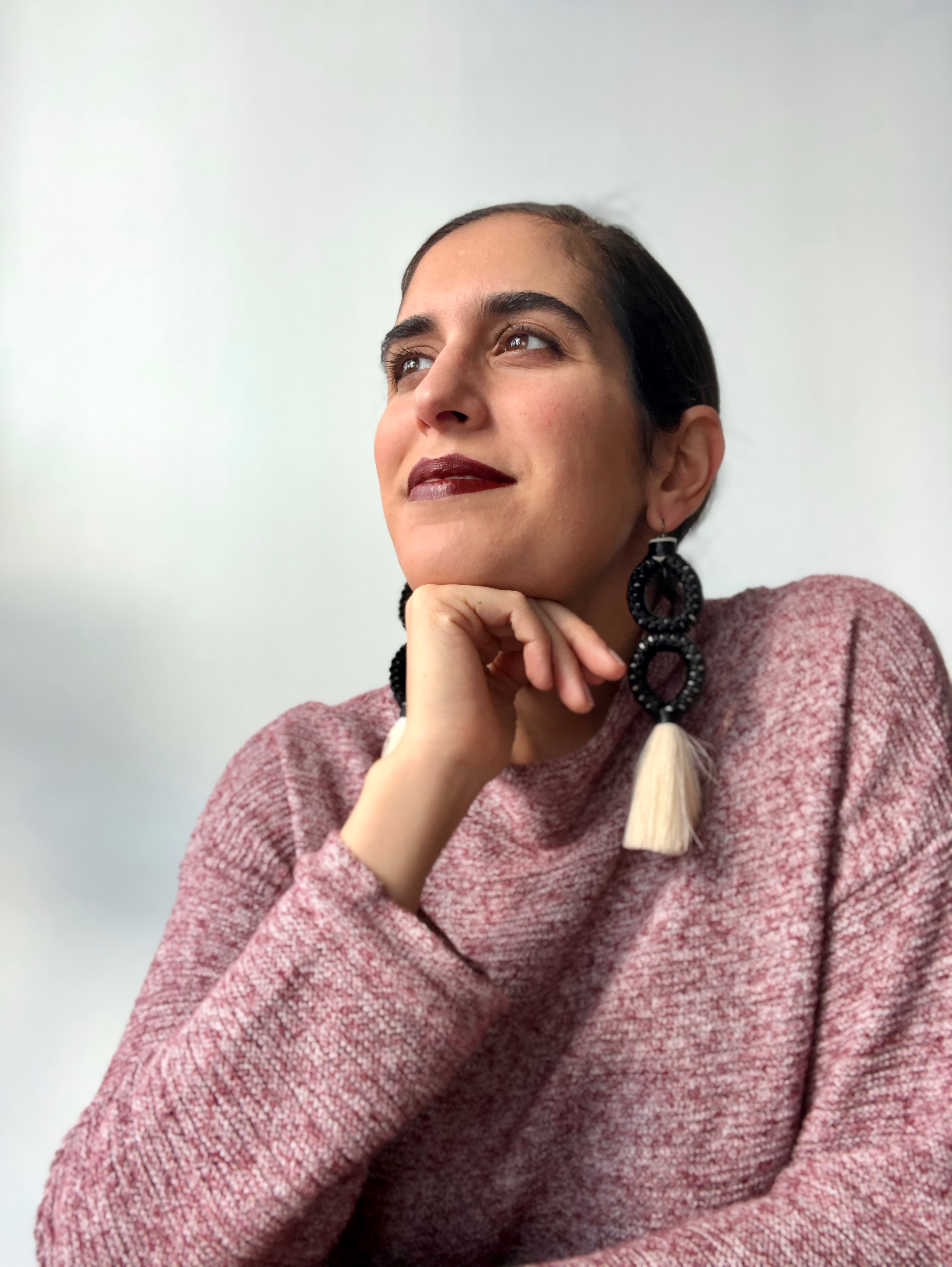How this new brand is introducing Canadians to Latin American fashion
Photo courtesy of Carolina Delgado. Design by Jeimy Ángulo.
LEE ESTE POST EN ESPAÑOL.
In November of 2019, Elana Hazghia launched Sania: Canada’s first curated collection of contemporary, conscious fashion from Latin America. Why do this? Because it didn’t exist. Elana wanted to expose Canadians to a rarely-seen side of Latin America that she’s come to personally know and love, shattering stereotypes of what it means to create well-made, ethical fashion from Latin America.
The name Sania derives from the Spanish word artesanía or craftsmanship, the quality of design and work shown in something made by hand. Sania curates a collection of statements and staples: “Pieces that make heads turn and spark conversation,” in Hazghia’s own words. “Pieces that you wear into the ground. Pieces that are contemporary, bold, and of high-quality construction and craftsmanship.”
Elana is an Iranian-American-Canadian with a passion for Latin America, initially rooted, as she puts it, “in nothing more than an affinity for the Spanish language.” Hazghia’s love for the language, region and people grew as her career took her all over Latin America.
She’s worked in international business and partnerships for almost a decade, working across borders and industries—from implementing complex health technology programs in the DR Congo to building a cross-cultural arts program in Guatemala. A native New Yorker born in London, and now living in Toronto, Elana is looking to fill a gap in the market.
Keep reading for Elana’s personal narrative, detailing what sparked her business idea, and the passion for the Latin American region that led her down this path.
“I always saw Latin America as the world’s hidden business opportunity.”
“Because her Spanish isn’t good enough”. I looked at my friend as we looked over Lake Atitlán, quite possibly one of the most beautiful and mystifying bodies of water I’ve seen in my life. Perched up on a large rock by our afternoon swim spot, I looked at her, searching for a solution. Neither of us had one.
We had just finished a morning of photography classes with about 20 children from La Básica, the primary school in San Marcos La Laguna, Guatemala, a small, quiet town that appealed to hippy backpackers looking for a Thai massage and basic accommodations. Beyond these waterfront hostels and holistic healing centres were mountains from which our students descended after spending the morning helping their parents tend to the house or farm work. Their classes ended promptly at 1pm, allowing them to spend the afternoon working at restaurants and hostels to further support their families. This was the rhythm of their lives.
Photo courtesy of Alepel.
I asked my friend if we could get a scholarship for one of our students, María, who was the most responsible and hardworking person in our class. I wanted to find a way to give her more opportunities. My friend said that private schools give scholarships to indigenous children, but in this case, her Spanish wasn’t good enough. And she was right. I saw the spelling mistakes in her writing, the grammatical errors in her melodic speech. Her native language was Kaqchikel, one of the 21 Mayan languages spoken in Guatemala. In school, they learned Spanish. But the quality of education was not up to par, and it became very clear that this was one of the main hindrances to their advancement.
At the same time, in a conversation with María by the lake one morning, I asked her if she could live anywhere in the world, where would she live. Her answer was, “Here, because my home is beautiful.” So, who was I to extract her from the place she knew and loved?
This was now a decade ago, and this moment is burned in my memory as the first of many moments that I saw Latin America’s issues as much more complex than I thought. Sitting 3,500 miles away were the university classrooms where I read the stories of Carlos Fuentes and wrote essays about tax evasion in Guatemala. I thought I had it all figured out. It was so easy to draw conclusions from afar. Elite = bad, indigenous = oppressed, humanitarian aid = good. I drew conclusions in my essays so that I could comfortably place a period at the end of my sentences. But in the ten years following that moment in San Marcos La Laguna, every interaction made it more and more difficult for me to place a period at the end of a sentence, to draw a definitive conclusion, to come up with the perfect solution.
“I want to create experiences that allow people to better understand the real, modern Latin America here in Canada.”
Photo courtesy of Rene Habie.
In those same ten years, I became more and more exposed to positive, innovative, sustainable initiatives that were slowly chipping away at some of the seemingly insurmountable issues in Latin America. Young local politicians who were making a difference in their communities, innovators who used technology to advance education, designers who were providing job security, skills training, and basic healthcare. Some initiatives worked, others didn’t. I dove into the failures to understand what went wrong. I met those innovators whose initiatives were creating tangible change and asked them about their thought processes and motivation. No one person had all the answers to the region’s problems—but pieced together these initiatives formed a tapestry of positive, thoughtful work that would transform the way I thought about social impact.
As the years passed I continued to collect learnings, good and bad. There were a couple of nagging thoughts lingering in the back of my mind. The kind of thoughts you often push away because you have to catch the train to work, go meet a friend for dinner, or wake up early for a flight.
“I wanted to curate a collection that broke stereotypes of what it means to be an ethical brand from Latin America.”
The first was the need to highlight and support businesses and innovators who were contributing to this tapestry of good work across the region. I had the fortune of seeing a Latin America that I never saw in the classroom, and that most people don’t see in headlines. I always saw Latin America as the world’s hidden business opportunity, and I wanted to show others the innovative projects and successes I saw throughout the region.
The second was a nagging desire to do something creative. I know a lot of people grapple with this. I’ve always enjoyed sketching, painting, and drawing. My father did too, and always kept it as a hobby. And so did I. I didn’t think much would come of it professionally. But my mind has always been visual. I walk through the world with a permanent viewfinder before my eyes. I constantly log what’s in front of me as potential paintings or photographs. I just didn’t do much with it. Some images are catalogued in my mind, and others filtered out.
I also grew an attachment to accessories that I accumulated in my travels—a baby alpaca scarf from a multi-generational textile factory in northern Spain, hand-cut brass earrings from a designer’s studio in South Africa, a gold disk necklace from a street market in Buenos Aires I wandered upon during an aimless walk around the city. When I wear each piece, they evoke a sense of fondness for a place that is still there, but a moment that is left in my memory. I treat those pieces differently than I do others, almost as if I damaged or lost it, the memory would be gone with it. I knew I somehow wanted to recreate that sense of wanderlust and fondness for others.
Earrings by Caralarga.
So, after a year or so of mulling over this idea, I decided to do it. It’s interesting to hear how people started their companies. Some have great opportunities fall into their lap, others spend years brainstorming and looking for financing. I was driven by instinct, as I am with most major decisions I make (although I’ve learned to sharpen this quality over time). But I had an immediate sense of aesthetic. I knew how I wanted Sania to look and feel. I knew the feeling I wanted to evoke in my audience. I knew the kinds of designers I wanted to work with. I knew that I wanted to bring pieces into Canada that have never been in the market. I was less sure about the business model and financing. But those were aspects of the business that I worked out as I developed the idea.
In a span of four months, I had the space and clarity to prepare for launch. One of the most rewarding and exciting aspects of starting was selecting, vetting and getting to know my partner designers. Some I knew for years, others I came across through Instagram, recommendations from friends, or reading local fashion blogs.
I interviewed my partner designers to better understand each business model, aesthetic, creative process, and social impact. As brands that were all new to the Canadian market, I wanted to curate a collection that broke stereotypes of what it means to be an ethical brand from Latin America. I wanted to shatter any preconceived idea of what it means to be Latin American, and what it means to have a company that simultaneously cares for the wellbeing of their artisans and the aesthetic and quality of their product.
I was proud of the designers I had on board for the launch. Not only did their aesthetics align with our vision, but each one had a unique approach to social impact. Aysha Bilgrami creates bold, evocative jewelry with recycled and refined silver from x-rays and other medical and electronics industry waste in Colombia. Caralarga utilizes recycled cotton thread from one of the first textile factories in Mexico and works with female artisans to create thoughtful woven jewelry and home furnishings. René Habie works with expert artisans in Antigua, Guatemala to create modern jewelry with sustainable materials.
By November 2019, I had assembled a group of brands from Colombia, Mexico, Guatemala, and Venezuela. I launched Sania with the click of a “send” button on a media blast. It was pleasantly shocking and encouraging to see how receptive people were to the brand and our aesthetic.
As I prepared for the holiday season, I dove into the deep end. I did a total of six pop-ups in and around Toronto over the course of two months. It was exhausting and rewarding, allowing me to interact with people and better understand what products people respond to, how they feel about price points, and who this elusive customer of mine actually may be.
When I picked up my head in early 2019, I had the space to think about what I want for the future of the brand. I want Sania to be more than an e-commerce website that occasionally does pop ups. I want to create experiences that allow people to better understand the real, modern Latin America here in Canada. What I see for the future of Sania is a space where experience and fashion intersect—talks about ethical fashion, exhibitions of contemporary Latin American artists, Latin American coffee tastings, etc. I have started down this path, and I know that there’s so much further to go. But as has been the case with most of my professional experiences, it’s up to me to create that opportunity.
“What I see for the future of Sania is a space where experience and fashion intersect—talks about ethical fashion, exhibitions of contemporary Latin American artists, Latin American coffee tastings, etc.”
Photo courtesy of Carolina Delgado.







